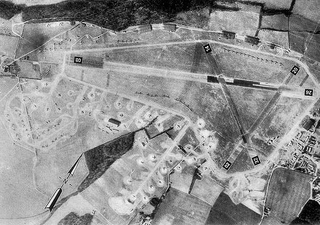
The Tenth Air Force is a unit of the U.S. Air Force, specifically a numbered air force of the Air Force Reserve Command (AFRC). 10 AF is headquartered at Naval Air Station Fort Worth Joint Reserve Base/Carswell Field, Texas.

Hanscom Air Force Base (AFB) is a United States Air Force base located predominantly within Bedford, Massachusetts, with portions extending into the adjoining towns of Lincoln, Concord and Lexington. The facility is adjacent to Hanscom Field which provides general aviation and charter service.

Royal Air Force Atcham, or more simply RAF Atcham, is a former Royal Air Force station located 5 miles (8 km) east of Shrewsbury, Shropshire, England, on the north eastern boundary of Attingham Park.

Royal Air Force Ramsbury or more simply RAF Ramsbury is a former Royal Air Force station, 5 miles (8 km) east-northeast of Marlborough, Wiltshire, England.

Santo International Airport is an airport in Luganville on Espiritu Santo in Vanuatu. The airport used to be called Santo-Pekoa International airport until it was renamed in the Vanuatu AIPV amendment released on 16 June 2021. Airports Vanuatu Limited provides aviation services for the airport.

Bakalar Air Force Base is a former U.S. Air Force base located 4.4 miles (7.1 km) northeast of Columbus, Indiana. During World War II, the base was known as Atterbury Air Field and Atterbury Army Air Base, but it was renamed Bakalar Air Force Base in 1954 in honor of First Lieutenant John Edmond Bakalar, USAAF. Established in 1942, the airfield served as a training base for medium-range C-46 Commando and C-47 Skytrain troop carrier planes and glider pilots. It also was used for training B-25 Mitchell and B-26 Marauder bomber crews. Reactivated during the Cold War, it was used as an Air Force Reserve training base for troop carrier, tactical airlift, and special operations flying units. The military base was closed in 1970. The present-day facility operates as the Columbus Municipal Airport.
During World War II, the U.S. Army Air Forces (USAAF) established numerous airfields in Arkansas for training fighter and bomber pilots and aircrews.
During World War II, the United States Army Air Forces (USAAF) established numerous airfields in Georgia for antisubmarine defense in the Gulf of Mexico and for training pilots and aircrews of USAAF fighters and bombers.
During World War II, the United States Army Air Forces (USAAF) established numerous airfields in Mississippi for antisubmarine defense in the Gulf of Mexico and for training pilots and aircrews of USAAF fighters and bombers.
During World War II, the United States Army Air Forces (USAAF) established numerous airfields in Idaho for training pilots and aircrews of USAAF fighters and bombers.
During World War II, the United States Army Air Forces (USAAF) established numerous airfields in Utah for training pilots and aircrews of USAAF fighters and bombers.
During World War II, the United States Army Air Forces (USAAF) established numerous airfields in Wyoming for training pilots and aircrews of USAAF fighters and bombers.
In Wisconsin multiple airfields were constructed and used by the United States Army Air Forces during World War II. The main purpose of these installations was for training pilots and aircrews of USAAF fighters and bombers.

The 307th Operations Group is an Air Reserve Component of the United States Air Force. It is assigned to the 307th Bomb Wing, Air Force Reserve Command, stationed at Barksdale Air Force Base, Louisiana.

Cross City Air Force Station is a former United States Air Force facility, located 1.6 miles (2.6 km) east of Cross City, Florida.

The 31st Operations Group is the flying component of the 31st Fighter Wing, assigned to the United States Air Forces in Europe. It is stationed at Aviano Air Base, Italy.

Grand Island Army Airfield was a United States Army Air Forces airfield which operated from 1942 to 1946. After its closure, the base was reopened as Central Nebraska Regional Airport.
Gillespie Airport is a former airport in Nashville, Tennessee.It was opened in 1941. During World War II, it was leased to the United States Army Air Forces as a training airfield.

Bangor Air National Guard Base is a United States Air National Guard base located on the grounds of Bangor International Airport in Bangor, Maine.













